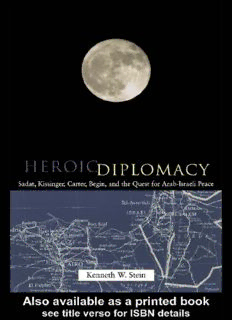
Heroic Diplomacy: Sadat, Kissinger, Carter, Begin and the Quest for Arab-Israeli Peace PDF
Preview Heroic Diplomacy: Sadat, Kissinger, Carter, Begin and the Quest for Arab-Israeli Peace
HEROIC DIPLOMACY HEROIC D I P L O M AC Y SADAT, KISSINGER, CARTER, BEGIN, AND THE QUEST FOR ARAB-ISRAELI PEACE KENNETH W.STEIN ROUTLEDGE NEW YORK LONDON Published in 1999 by Routledge 29 West 35th Street New York, NY 10001 This edition published in the Taylor & Francis e-Library, 2003. Published in Great Britain by Routledge 11 New Fetter Lane London EC4P 4EE Copyright © 1999 by Routledge All rights reserved. No part of this book may be reprinted or reproduced or utilized in any form or by any electronic, mechanical, or other means, now known or hereafter invented, including photocopying and recording or in any information storage or retrieval system, without permission in writing from the publisher. LIBRARY OF CONGRESS CATALOGING-IN-PUBLICATION DATA Stein, Kenneth W., 1946– Heroic diplomacy: Sadat, Kissinger, Carter, Begin, and the quest for Arab-Israeli peace/Kenneth W.Stein. p. cm. Includes bibliographical references and index. ISBN 0-415-92155-4 (pbk.).—ISBN 0-415-92154-6 (cloth) 1. Arab-Israeli conflict—1973–1993. 2. Diplomatic negotiations in international disputes. 3. Arab countries—Foreign relations—Israel. 4. Israel—Foreign relations—Arab countries. 5. Israel-Arab war, 1973—Peace. 6. Arab-Israeli conflict—1993—Peace. I. Title. DS119.7.S6749 1999 956.04–dc21 98–49359 CIP ISBN 0-203-90522-9 Master e-book ISBN ISBN 0-203-90615-2 (Adobe eReader Format) ISBN 0-415-92155-4 (Print Edition) Dedicated to my parents, Tillie and Max Stein, and my students CONTENTS Preface ix Acknowledgments xiii CHAPTER 1 The Key Players in Arab-Israeli Diplomacy 1973–1978 1 CHAPTER 2 The Arab-Israeli Conflict 1947–1973 46 CHAPTER 3 The October 1973 War 74 CHAPTER 4 From War to Diplomacy The Kilometer 101 Talks 97 vii Contents CHAPTER 5 The 1973 Geneva Middle East Peace Conference and the Buildup to Sinai I 117 CHAPTER 6 The Syrian-Israeli Agreement, Sinai I and II, and Defining a Comprehensive Peace 1974–1977 146 CHAPTER 7 Unintended Consequences The 1977 Road to Geneva Ends in Jerusalem 187 CHAPTER 8 From Jerusalem to Oslo and Beyond 1978–1998 229 Appendix 269 Notes 275 Works Cited and Suggested Reading 313 Index 321 viii PREFACE AFTER ISRAEL’S establishment in May 1948, the Arab world refused to make peace with the new Jewish state. Though Arab states signed armistice agreements with Israel in 1949, a technical state of war remained in effect. Attempts to sign formal peace agreements between Israel and Jordan, and Israel and Syria continually failed, and no Palestinian Arab-Israeli accommodation was seriously considered. The states were locked into a catch-22 situation: Israel would not allow Palestinian refugees to return to the new Jewish state’s territory until Arab states recognized it diplomatically; Arab states would not recognize Israel until Israel allowed Palestinians, displaced by Israel’s creation, to return to their land within the new state. The Arab world saw Israel as an extension of Western imperial presence in the Middle East. It was also a blight on the Arab character and required removal. Egyptian President Nasser cemented an Arab commitment, which endured for two decades, to seek Israel’s destruction. Under pressure to survive in this hostile environment, Israel developed a secure economy, integrated millions of new immigrants, and built an army supported by weapons capable of protecting its national security. For their part, many Arab states, including Egypt, Syria, and Iraq, responded by looking to the Soviet Union for equivalent military hardware. In this manner the cold war further complicated the Arab-Israeli conflict. In June 1967, mounting tension exploded into war. Without warning, Israel premptively attacked Syria and Egypt, and then Jordan. Israel’s lightening military victories solidified an Arab fear: the unlikelihood of Israel’s destruction. The Arab world responded: “No peace, no recognition, no negotiations with Israel.” But the international community, working with the United Nations, set forth principles that could govern eventual negotiations. Security Council Resolution 242 of November 1967 became a framework for future negotiations. It called for the sovereignty, independence, and territorial integrity of all states in the region and a solution to the growing refugee problem, and stated an admissibility of the acquisition of territory through war. Along with this general outline, several negotiating mechanisms were tried, among them third-party mediation, great- power talks, private diplomacy, and secret meetings. As Egypt’s new president in 1970, Anwar Sadat sought to alter Nasser s priorities and change Egypt’s political ix
Description: